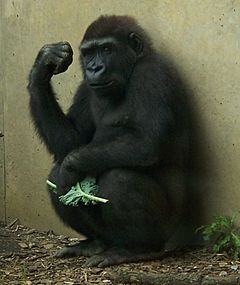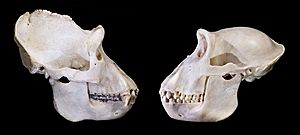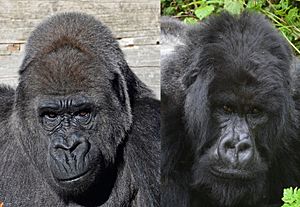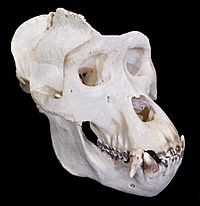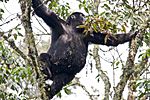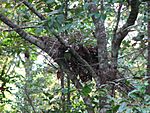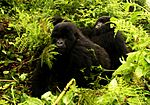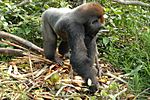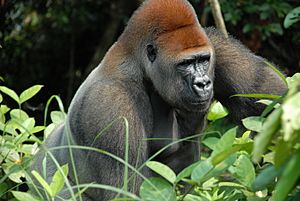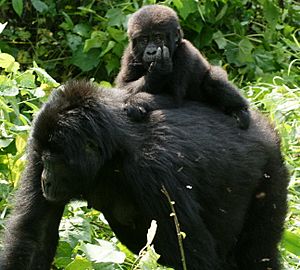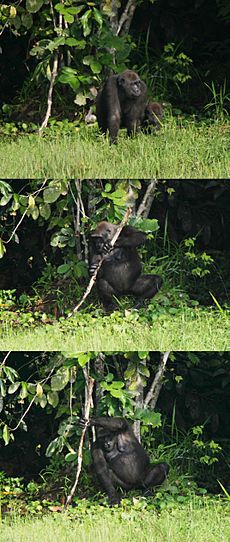Gorilla facts for kids
Quick facts for kids Gorilla |
|
|---|---|
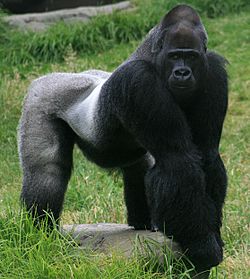 |
|
| Silverback male Gorilla gorilla | |
| Scientific classification | |
| Kingdom: | |
| Class: | |
| Order: | |
| Family: | |
| Subfamily: | |
| Genus: |
Gorilla
|
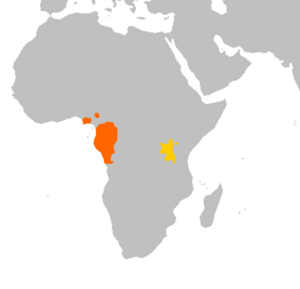 |
|
| Distribution of gorillas | |
Gorillas are ground-dwelling, predominantly herbivorous apes that inhabit the forests of central Sub-Saharan Africa. The genus Gorilla is divided into two species: the eastern gorillas and the western gorillas (both critically endangered), and either four or five subspecies. They are the largest living primates. The DNA of gorillas is highly similar to that of humans, from 95–99% depending on what is counted, and they are the next closest living relatives to humans after the chimpanzees and bonobos.
Gorillas' natural habitats cover tropical or subtropical forests in Sub-Saharan Africa. Although their range covers a small percentage of Africa, gorillas cover a wide range of elevations. The mountain gorilla inhabits the Albertine Rift montane cloud forests of the Virunga Volcanoes, ranging in altitude from 2,200–4,300 metres (7,200–14,100 ft). Lowland gorillas live in dense forests and lowland swamps and marshes as low as sea level, with western lowland gorillas living in Central West African countries and eastern lowland gorillas living in the Democratic Republic of the Congo near its border with Rwanda.
Contents
Etymology
The word "gorilla" comes from the history of Hanno the Navigator, (c. 500 BC) a Carthaginian explorer on an expedition on the west African coast to the area that later became Sierra Leone. Members of the expedition encountered "savage people, the greater part of whom were women, whose bodies were hairy, and whom our interpreters called Gorillae". The word was then later used as the species name, though it is unknown whether what these ancient Carthaginians encountered were truly gorillas, another species of ape or monkeys, or humans.
The American physician and missionary Thomas Staughton Savage and naturalist Jeffries Wyman first described the western gorilla (they called it Troglodytes gorilla) in 1847 from specimens obtained in Liberia. The name was derived from Ancient Greek [Γόριλλαι (gorillai)] Error: {{Lang}}: text has italic markup (help), meaning 'tribe of hairy women', described by Hanno.
Evolution and classification
The closest relatives of gorillas are the other two Homininae genera, chimpanzees and humans, all of them having diverged from a common ancestor about 7 million years ago. Human gene sequences differ only 1.6% on average from the sequences of corresponding gorilla genes, but there is further difference in how many copies each gene has. Until recently, gorillas were considered to be a single species, with three subspecies: the western lowland gorilla, the eastern lowland gorilla and the mountain gorilla. There is now agreement that there are two species, each with two subspecies. More recently, a third subspecies has been claimed to exist in one of the species. The separate species and subspecies developed from a single type of gorilla during the Ice Age, when their forest habitats shrank and became isolated from each other.
Primatologists continue to explore the relationships between various gorilla populations. The species and subspecies listed here are the ones upon which most scientists agree.
The proposed third subspecies of Gorilla beringei, which has not yet received a trinomen, is the Bwindi population of the mountain gorilla, sometimes called the Bwindi gorilla.
Some variations that distinguish the classifications of gorilla include varying density, size, hair colour, length, culture, and facial widths. Population genetics of the lowland gorillas suggest that the western and eastern lowland populations diverged ~261 thousand years ago.
Physical characteristics
Gorillas move around by knuckle-walking, although they sometimes walk bipedally for short distances while carrying food or in defensive situations. Wild male gorillas weigh 135 to 195 kg (300 to 430 lb) while adult females usually weigh half as much as adult males at 70–115 kg (150–250 lb). Adult males are 1.5 to 1.8 m (4 ft 11 in to 5 ft 11 in) tall, with an arm span that stretches from 2.3 to 2.6 m (7 ft 7 in to 8 ft 6 in). Female gorillas are shorter, with smaller arm spans. Adult male gorillas are known as silverbacks due to the characteristic silver hair on their backs reaching to the hips. The tallest gorilla recorded was a 1.95 m (6 ft 5 in) silverback with an arm span of 2.7 m (8 ft 10 in), a chest of 1.98 m (6 ft 6 in), and a weight of 219 kg (483 lb), shot in Alimbongo, northern Kivu in May 1938. The heaviest gorilla recorded was a 1.83 m (6 ft 0 in) silverback shot in Ambam, Cameroon, which weighed 267 kilograms (589 lb). Males in captivity are noted to be capable of reaching weights up to 275 kg (606 lb). Gorilla facial structure is described as mandibular prognathism, that is, the mandible protrudes farther out than the maxilla. Adult males also have a prominent sagittal crest.
The eastern gorilla is more darkly coloured than the western gorilla, with the mountain gorilla being the darkest of all. The mountain gorilla also has the thickest hair. The western lowland gorilla can be brown or grayish with a reddish forehead. In addition, gorillas that live in lowland forests are more slender and agile than the more bulky mountain gorillas. The eastern gorilla also has a longer face and broader chest than the western gorilla.
Studies have shown gorilla blood is not reactive to anti-A and anti-B monoclonal antibodies, which would, in humans, indicate type O blood. Due to novel sequences, though, it is different enough to not conform with the human ABO blood group system, into which the other great apes fit. Like humans, gorillas have individual finger prints. Their eye colour is dark brown, framed by a black ring around the iris.
Distribution and habitat
Gorillas have a patchy distribution. The range of the two species is separated by the Congo River and its tributaries. The western gorilla lives in west central Africa, while the eastern gorilla lives in east central Africa. Between the species, and even within the species, gorillas live in a variety of habitats and elevations. Gorilla habitat ranges from montane forests to swamps. Eastern gorillas inhabit montane and submontane forests between 650 and 4,000 m (2,130 and 13,120 ft) above sea level. Mountain gorillas live in the montane forests at the higher ends of the elevation range, while eastern lowland gorillas live in submontane forests at the lower ends of the elevation range. In addition, eastern lowland gorillas live in montane bamboo forests, as well as lowland forests ranging from 600–3,308 m (1,969–10,853 ft) in elevation. Western gorillas live in both lowland swamp forests and montane forests, and elevations ranging from sea level to 1,600 m (5,200 ft). Western lowland gorillas live in swamp and lowland forests ranging up to 1,600 m (5,200 ft), and Cross River gorillas live in low-lying and submontane forests ranging from 150–1,600 m (490–5,250 ft).
Nesting
Gorillas construct nests for daytime and night use. Nests tend to be simple aggregations of branches and leaves about 2 to 5 ft (0.61 to 1.52 m) in diameter and are constructed by individuals. Gorillas, unlike chimpanzees or orangutans, tend to sleep in nests on the ground. The young nest with their mothers, but construct nests after three years of age, initially close to those of their mothers. Gorilla nests are distributed arbitrarily and use of tree species for site and construction appears to be opportunistic. Nest-building by great apes is now considered to be not just animal architecture, but as an important instance of tool use.
Food and foraging
A gorilla's day is synchronized, divided between rest periods and travel or feeding periods. Diets differ between and within species. Mountain gorillas mostly eat foliage, such as leaves, stems, pith, and shoots, while fruit makes up a very small part of their diets. Mountain gorilla food is widely distributed and neither individuals nor groups have to compete with one another. Their home ranges average 3–15 km2 (1.16–5.79 mi2), and their movements range around 500 m (0.31 mi) or less on an average day. Despite eating a few species in each habitat, mountain gorillas have flexible diets and can live in a variety of habitats.
Eastern lowland gorillas have more diverse diets, which vary seasonally. Leaves and pith are commonly eaten, but fruits can make up as much as 25% of their diets. Since fruit is less available, lowland gorillas must travel farther each day, and their home ranges vary from 2.7–6.5 km2 (1.04 to 2.51 mi2), with day ranges 154–2,280 m (0.096–1.417 mi). Eastern lowland gorillas will also eat insects, preferably ants. Western lowland gorillas depend on fruits more than the others and they are more dispersed across their range. They travel even further than the other gorilla subspecies, at 1,105 m (0.687 mi) per day on average, and have larger home ranges of 7–14 km2 (2.70–5.41 mi2). Western lowland gorillas have less access to terrestrial herbs, although they can access aquatic herbs in some areas. Termites and ants are also eaten.
Gorillas rarely drink water "because they consume succulent vegetation that is comprised of almost half water as well as morning dew", although both mountain and lowland gorillas have been observed drinking.
Behaviour
Social structure
Gorillas live in groups called troops. Troops tend to be made of one adult male or silverback, multiple adult females and their offspring. However, multiple-male troops also exist. A silverback is typically more than 12 years of age, and is named for the distinctive patch of silver hair on his back, which comes with maturity. Silverbacks also have large canine teeth that also come with maturity. Both males and females tend to emigrate from their natal groups. For mountain gorillas, females disperse from their natal troops more than males. Mountain gorillas and western lowland gorillas also commonly transfer to second new groups.
Mature males also tend to leave their groups and establish their own troops by attracting emigrating females. However, male mountain gorillas sometimes stay in their natal troops and become subordinate to the silverback. If the silverback dies, these males may be able to become dominant or mate with the females.
The silverback is the center of the troop's attention, making all the decisions, mediating conflicts, determining the movements of the group, leading the others to feeding sites, and taking responsibility for the safety and well-being of the troop. Younger males subordinate to the silverback, known as blackbacks, may serve as backup protection. Blackbacks are aged between 8 and 12 years and lack the silver back hair. The bond that a silverback has with his females forms the core of gorilla social life. Bonds between them are maintained by grooming and staying close together. Females form strong relationships with males to gain mating opportunities and protection from predators and infanticidal outside males. However, aggressive behaviours between males and females do occur, but rarely lead to serious injury. Relationships between females may vary. Maternally related females in a troop tend to be friendly towards each other and associate closely. Otherwise, females have few friendly encounters and commonly act aggressively towards each other.
Females may fight for social access to males and a male may intervene. Male gorillas have weak social bonds, particularly in multiple-male groups with apparent dominance hierarchies and strong competition for mates. Males in all-male groups, though, tend to have friendly interactions and socialise through play, grooming, and staying together, and occasionally they even engage in homosexual interactions. Severe aggression is rare in stable groups, but when two mountain gorilla groups meet, the two silverbacks can sometimes engage in a fight to the death, using their canines to cause deep, gaping injuries.
Competition
One possible predator of gorillas is the leopard. Gorilla remains have been found in leopard scat, but this may be the result of scavenging. When the group is attacked by humans, leopards, or other gorillas, an individual silverback will protect the group, even at the cost of his own life. George Schaller reported, "[a] silverback gorilla and a leopard were both found dead from mutually inflicted wounds".
Reproduction and parenting
Females mature at 10–12 years (earlier in captivity), and males at 11–13 years. The gestation period lasts 8.5 months. Female mountain gorillas first give birth at 10 years of age and have four-year interbirth intervals. Males can be fertile before reaching adulthood. Gorillas mate year round.
Gorilla infants are vulnerable and dependent, thus mothers, their primary caregivers, are important to their survival. Male gorillas are not active in caring for the young, but they do play a role in socialising them to other youngsters. The silverback has a largely supportive relationship with the infants in his troop and shields them from aggression within the group. Infants remain in contact with their mothers for the first five months and mothers stay near the silverback for protection. Infants suckle at least once per hour and sleep with their mothers in the same nest.
Infants begin to break contact with their mothers after five months, but only for a brief period each time. By 12 months old, infants move up to five meters (16 feet) from their mothers. At around 18–21 months, the distance between mother and offspring increases and they regularly spend time away from each other. In addition, nursing decreases to once every two hours. Infants spend only half of their time with their mothers by 30 months. They enter their juvenile period at their third year, and this lasts until their sixth year. At this time, gorillas are weaned and they sleep in a separate nest from their mothers. After their offspring are weaned, females begin to ovulate and soon become pregnant again. The presence of play partners, including the silverback, minimizes conflicts in weaning between mother and offspring.
Communication
Twenty-five distinct vocalisations are recognised, many of which are used primarily for group communication within dense vegetation. Sounds classified as grunts and barks are heard most frequently while traveling, and indicate the whereabouts of individual group members. They may also be used during social interactions when discipline is required. Screams and roars signal alarm or warning, and are produced most often by silverbacks. Deep, rumbling belches suggest contentment and are heard frequently during feeding and resting periods. They are the most common form of intragroup communication.
For this reason, conflicts are most often resolved by displays and other threat behaviours that are intended to intimidate without becoming physical. The ritualized charge display is unique to gorillas. The entire sequence has nine steps: (1) progressively quickening hooting, (2) symbolic feeding, (3) rising bipedally, (4) throwing vegetation, (5) chest-beating with cupped hands, (6) one leg kick, (7) sideways running, two-legged to four-legged, (8) slapping and tearing vegetation, and (9) thumping the ground with palms to end display.
Lifespan
A gorilla's lifespan is normally between 35 and 40 years, although zoo gorillas may live for 50 years or more. Colo, a female western gorilla at the Columbus Zoo and Aquarium was the oldest known gorilla, at 60 years of age when she died on January 17, 2017.
Intelligence
Gorillas are considered highly intelligent. A few individuals in captivity, such as Koko, have been taught a subset of sign language. Like the other great apes, gorillas can laugh, grieve, have "rich emotional lives", develop strong family bonds, make and use tools, and think about the past and future. Some researchers believe gorillas have spiritual feelings or religious sentiments. They have been shown to have cultures in different areas revolving around different methods of food preparation, and will show individual colour preferences.
Tool use
The following observations were made by a team led by Thomas Breuer of the Wildlife Conservation Society in September 2005. Gorillas are now known to use tools in the wild. A female gorilla in the Nouabalé-Ndoki National Park in the Republic of Congo was recorded using a stick as if to gauge the depth of water whilst crossing a swamp. A second female was seen using a tree stump as a bridge and also as a support whilst fishing in the swamp. This means all of the great apes are now known to use tools.
In September 2005, a two-and-a-half-year-old gorilla in the Republic of Congo was discovered using rocks to smash open palm nuts inside a game sanctuary. While this was the first such observation for a gorilla, over 40 years previously, chimpanzees had been seen using tools in the wild 'fishing' for termites. Great apes are endowed with semiprecision grips, and have been able to use both simple tools and even weapons, by improvising a club from a convenient fallen branch, for example.
Related pages
Images for kids
-
Drawing of French explorer Paul Du Chaillu at close quarters with a gorilla
-
Eastern lowland gorilla in the Kahuzi-Biega National Park, Democratic Republic of the Congo
See also
 In Spanish: Gorilla para niños
In Spanish: Gorilla para niños


